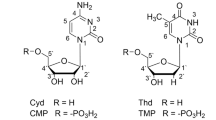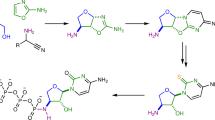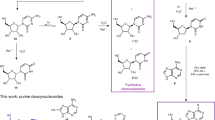Abstract
A PROBABLE explanation of the heterogeneous 32P-labelling of 5′-nucleotide units of ribonucleic acid of rat liver1 and deoxyribonucleic acid of thymine-requiring E. coli 2 after brief incubation with phosphate-32P is that the carbon-bound phosphate groups of postulated precursor 5′-nucleotides3 become labelled at unequal rates. Brumm, Potter and Siekevitz4 have studied the incorporation of phosphorus-32 into acid-soluble nucleotides of rat liver, but the isolated guanylic and uridylic acids were noted to contain impurities. Because there is little direct in vivo evidence that 5′-nucleotides actually are the building blocks in biosynthesis of nucleic acids in mammalian tissues, we have re-investigated the status of labelling after a short time of incubation, when unequal synthetic rates should be most easily observable.
This is a preview of subscription content, access via your institution
Access options
Subscribe to this journal
Receive 51 print issues and online access
$199.00 per year
only $3.90 per issue
Buy this article
- Purchase on Springer Link
- Instant access to full article PDF
Prices may be subject to local taxes which are calculated during checkout
Similar content being viewed by others
References
Shiguera, H. T., and Chargaff, E., J. Biol. Chem., 233, 197 (1958).
Price, T. D., Darmstadt, R. A., Hinds, H. A., and Hudson, P. B., Fed. Proc., 18, 305 (1959).
McElroy, W. D., and Glass, B., editors, “The Chemical Basis of Heredity” ( Kornberg, A., p. 579 ; Ochoa, S., and Heppel, L. A., p. 615) (Johns Hopkins Press, Baltimore, 1957). Harbers, E., and Heidelberger, C., Biochim. Biophys. Acta, 35, 381 (1959). Canellakis, E. S., Biochim. Biophys. Acta, 25, 217 (1957). Hecht, L. I., Zamecnik, P. C., Stephenson, M. L., and Scott, J. F., J. Biol. Chem., 233, 954 (1958).
Brumm, A. F., Potter, V. R., and Siekevitz, P., J. Biol. Chem., 220, 713 (1956).
Tsuboi, K. K., and Price, T. D., Arch. Biochem. Biophys., 81, 223 (1959).
Price, T. D., and Hudson, P. B., Anal. Chem., 26, 1127 (1954).
Hurlbert, R. B., Schmitz, H., Brumm, A. F., and Potter, V. R., J. Biol. Chem., 209, 23 (1954). Keir, H. M., and Davidson, J. N., Arch. Biochem. Biophys., 77, 68 (1958).
Price, T. D., and Hudson, P. B., Nucleonics, 13, 3, 54 (1955).
Leibman, K. C., and Heidelberger, C., J. Biol. Chem., 216, 823 (1955).
Moldave, K., and Heidelberger, C., J. Amer. Chem. Soc., 76, 679 (1954).
Buchanan, J. M., and Hartman, S. C., “Advances in Enzymology”, 21, 199 (1959). Reichard, P., ibid., 21, 263 (1959).
Author information
Authors and Affiliations
Rights and permissions
About this article
Cite this article
PRICE, T., TSUBOI, K., HINDS, H. et al. Heterogeneous Labelling of Acid-soluble Nucleoside 5′-Monophosphates during Short in vivo Incubation with Phosphate-32P. Nature 186, 158–160 (1960). https://doi.org/10.1038/186158b0
Issue Date:
DOI: https://doi.org/10.1038/186158b0
Comments
By submitting a comment you agree to abide by our Terms and Community Guidelines. If you find something abusive or that does not comply with our terms or guidelines please flag it as inappropriate.



